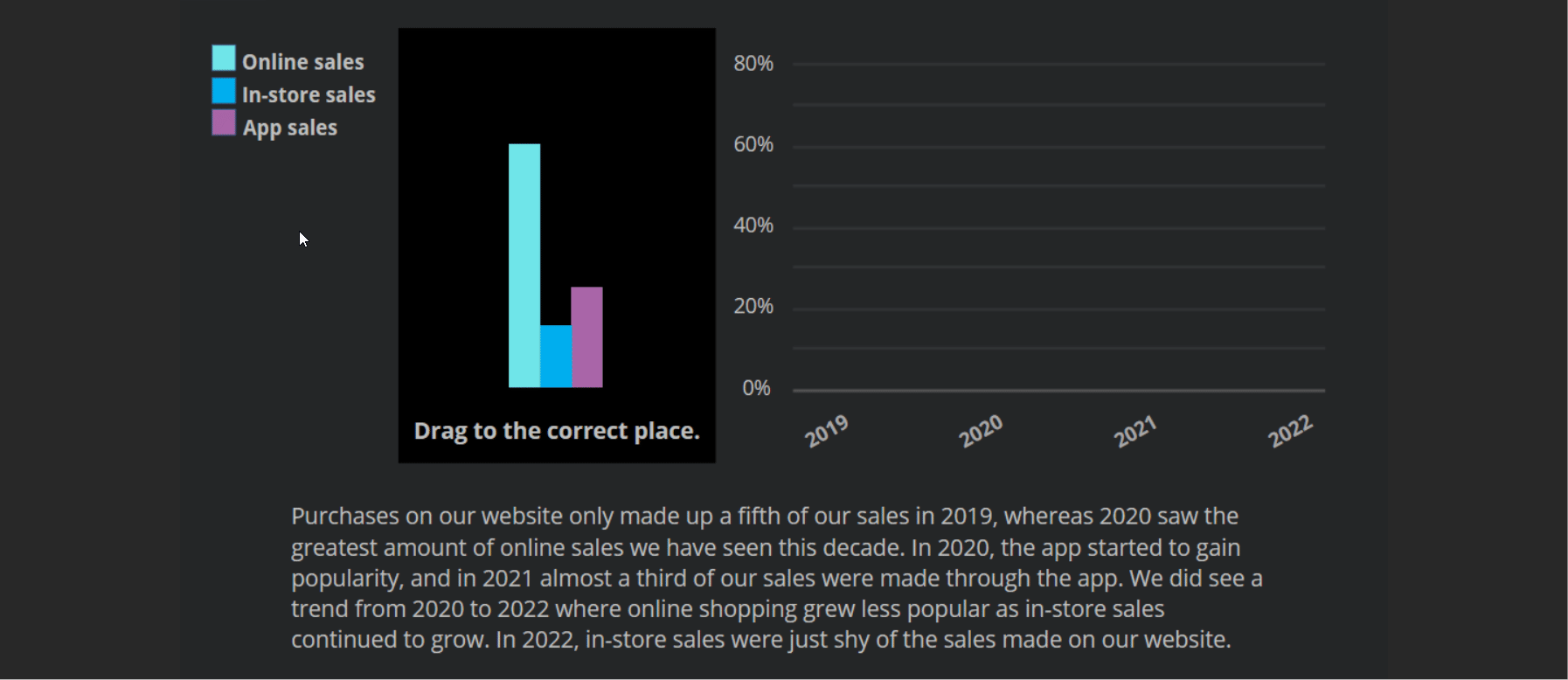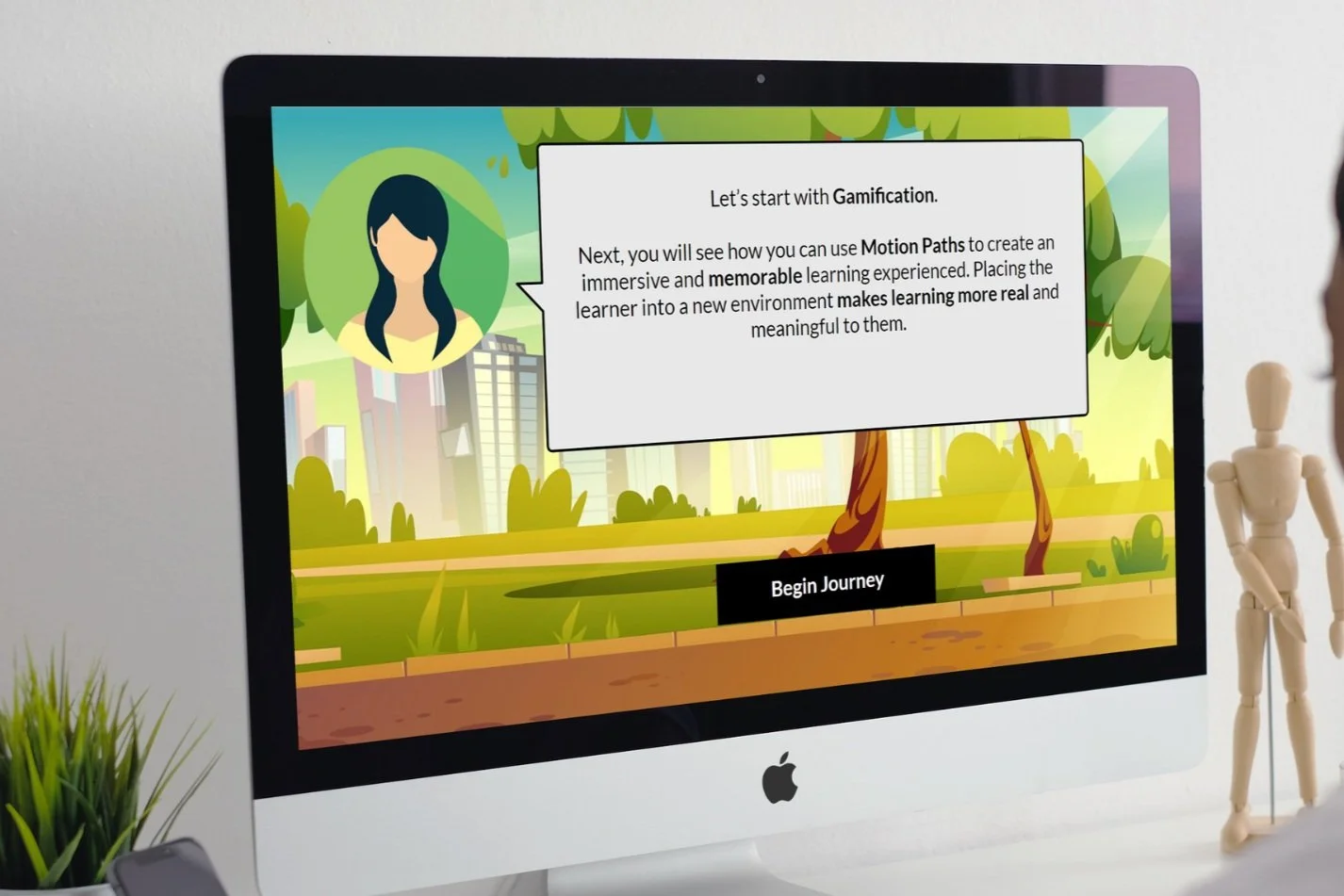

OVERVIEW
This interactive eLearning experience trains clients that work at large companies to communicate data more effectively to their teams and stakeholders.
Data Presentation Training
This interactive eLearning experience trains clients that work at large companies to communicate data more effectively to their teams and stakeholders.
Audience: clients at large companies
Responsibilities: Instructional Design, eLearning Development, Narration, and Graphic Design
Tools Used: Articulate Storyline 360, Canva, and Audacity
Data Presentation Training
This interactive eLearning experience trains clients that work at large companies to communicate data more effectively to their teams and stakeholders.
Audience: clients who work at large companies
Responsibilities: Instructional Design, eLearning Development, Narration, and Graphic Design
Tools Used: Articulate Storyline 360, Canva, and Audacity
I was tasked with updating training material and facilitating workshops for blended learning solutions. Our clients needed to improve their communication in sharing and presenting data and research findings with their team and key stakeholders.
As graphs and data are often considered to be very dry and technical, the challenge was making this training interesting while still ensuring that the lesson objectives are achieved. The learner analysis I conducted also showed that the learners struggled a lot with these skills.
I proposed a blended learning approach that combined eLearning with in-person training sessions. I designed, developed, and implemented a course utilizing handouts, activities, and eLearning. In the eLearning experiences, the learners could interact with and manipulate the different graphs they use in their workplace.
Problem and Solution
Process
In the first part of the eLearning experience, I introduce the necessary vocabulary and grammatical structures to the learners through classroom activities. Learners would come up to the front of the room and interact with the eLearning experience while discussing it together. Talking through these ideas in a social environment while interacting with the Storyline file made the lessons engaging and memorable.
This first interactive part had learners focus on the language used for describing line graphs, bar charts, pie charts, tables, processes, diagrams, and maps. The eLearning experience allowed them to hover over parts of the graph to learn phrases to describe it and drag and drop elements into the correct part of the graphs based on the text or audio.
Culinary Art eLearning Training for Newly Hired Cooks
This interactive eLearning experience trains cooks at a startup company by introducing the menu, the work environment, and the processes of cooking some of the entrees.
After seeing how these different graphs can be described, the learners were placed into groups where they practiced describing graphs. I made handouts for the learners to use as scaffolding to assist them in practicing these new skills. The exercise started out with simplified graphs at first and grew to more complex graphs over the course.
By combining the course material and the activities around the eLearning experience, the learners could really grasp the objective and they began applying the skills immediately. They were able to continue learning more from the eLearning experience on their own time using a computer or device.
Takeaways
Due to the success of the implementation phase of this blended learning project, I continued to develop this material and used it with other groups of learners.
I was really happy to see the learners’ enthusiasm during this training. They shared their heartfelt struggles in trying to explain graphs to important people at their company and how incredible it was that they were finally able to do it. It was clear that their confidence in these skills had improved, and they were surprised by how fun I made the learning experience.
This project combined two of my passions. I love the challenge of taking complex ideas and simplifying them so that learners can fully understand and apply the new skills to their workplace. I also enjoy the challenge of taking material that seems dull and making it fun and meaningful. I hope to work on more challenging projects like this in the future.
You may also like…
Diversity and Cultural Sensitivity Training
This scenario-based eLearning simulation was developed for an international organization to build cultural competency in a very diverse workplace.
Gamified Instructional Designer eLearning Experience
This interactive and gamified eLearning experience inspires instructional designers at a large company to use modern tools and features in their eLearning projects.
In this project, I successfully took a very complicated and dry topic and made it simple and interesting to learn.
I was tasked with updating training material and facilitating workshops for blended learning solutions. Our clients needed to improve their communication in sharing and presenting data and research findings with their team and key stakeholders.
As graphs and data are often considered to be very dry and technical, the challenge was making this training interesting while still ensuring that the lesson objectives are achieved. The learner analysis I conducted also showed that the learners struggled a lot with these skills.
I proposed a blended learning approach that combined eLearning with in-person training sessions. I designed, developed, and implemented a course utilizing handouts, activities, and eLearning. In the eLearning experiences, the learners could interact with and manipulate the different graphs they use in their workplace.
Problem and Solution
In this project, I successfully took a very complicated and dry topic and made it simple and interesting to learn.
Process
In the first part of the eLearning experience, I introduce the necessary vocabulary and grammatical structures to the learners through classroom activities. Learners would come up to the front of the room and interact with the eLearning experience while discussing it together. Talking through these ideas in a social environment while interacting with the Storyline file made the lessons engaging and memorable.
This first interactive part had learners focus on the language used for describing line graphs, bar charts, pie charts, tables, processes, diagrams, and maps. The eLearning experience allowed them to hover over parts of the graph to learn phrases to describe it and drag and drop elements into the correct part of the graphs based on the text or audio.
After seeing how these different graphs can be described, the learners were placed into groups where they practiced describing graphs. I made handouts for the learners to use as scaffolding to assist them in practicing these new skills. The exercise started out with simplified graphs at first and grew to more complex graphs over the course.
By combining the course material and the activities around the eLearning experience, the learners could really grasp the objective and they began applying the skills immediately. They were able to continue learning more from the eLearning experience on their own time using a computer or device.
Takeaways
Due to the success of the implementation phase of this blended learning project, I continued to develop this material and used it with other groups of learners.
I was really happy to see the learners’ enthusiasm during this training. They shared their heartfelt struggles in trying to explain graphs to important people at their company and how incredible it was that they were finally able to do it. It was clear that their confidence in these skills had improved, and they were surprised by how fun I made the learning experience.
This project combined two of my passions. I love the challenge of taking complex ideas and simplifying them so that learners can fully understand and apply the new skills to their workplace. I also enjoy the challenge of taking material that seems dull and making it fun and meaningful. I hope to work on more challenging projects like this in the future.
You may also like…
Diversity and Cultural Sensitivity Training
This scenario-based eLearning simulation was developed for an international organization to build cultural competency in a very diverse workplace.
Culinary Art eLearning Training for Newly Hired Cooks
This interactive eLearning experience trains cooks at a startup company by introducing the menu, the work environment, and the processes of cooking some of the entrees.
Gamified Instructional Designer eLearning Experience
This interactive and gamified eLearning experience inspires instructional designers at a large company to use modern tools and features in their eLearning projects.






